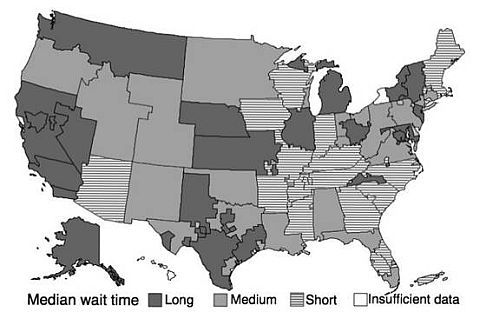Determinants of Geographic Variation in Access to Deceased Donor Kidney Transplantation for Children
University of Pennsylvania, Philadelphia, PA
Children's Hosp of Philadelphia, Philadelphia, PA
Meeting: 2013 American Transplant Congress
Abstract number: 389
The OPTN prioritizes pediatric candidates (<18 years) in kidney allocation because children derive unique benefits from kidney transplant (KT). However, because allocation usually starts locally, organ procurement organization (OPO) attributes – such as the supply of pediatric-quality kidneys and diversion of these kidneys to adults through multi-organ transplant and other mechanisms – could drive geographic variation in pediatric access to deceased donor KT.
Methods: We assembled a cohort of 3943 pediatric KT candidates from 2005 – 2010 with SRTR data. For each OPO, we assigned a category of short (<180), medium (181 – 270), or long (>270 days) median waiting time, and calculated a) the ratio of pediatric-quality kidneys (KDRI<1) to pediatric candidates and b) the % of these kidneys locally diverted to adults. Using multivariable Cox regression for the outcome of deceased donor KT (censored for live donor KT), we adjusted for individual (including demographics, renal disease, PRA and inactivity) and OPO attributes.
Results: Wide variation in waiting times and OPO-level characteristics was evident. The Kaplan-Meier estimate of the median wait for pediatric KT across all OPOs was 281 days. Overall, 29% of pediatric quality kidneys were diverted to adults. Compared to short waiting time OPOs, long waiting time OPOs had a lower ratio of quality kidneys to candidates (3.4 vs 6.8, p<0.001) and more diversions to adults (31% vs 26%, p<0.01). In the multivariable Cox regression, a higher kidney-candidate ratio remained associated with shorter waits (p=0.01) while kidney diversion to adults was not associated with waiting times. Results were similar in a stratified analysis limited to blood type O candidates.
Conclusions: Geographic variation in pediatric KT is highly associated with local supply-demand factors. Our analysis did not find an association between pediatric waiting time and diversions of kidneys to adults. Long waiting times for pediatric KT in some OPOs undermines a key allocation principle and creates a strong rationale for national sharing of kidneys for children.

To cite this abstract in AMA style:
Reese P, Hwang J, Potluri V, Abt P, Shults J, Amaral S. Determinants of Geographic Variation in Access to Deceased Donor Kidney Transplantation for Children [abstract]. Am J Transplant. 2013; 13 (suppl 5). https://atcmeetingabstracts.com/abstract/determinants-of-geographic-variation-in-access-to-deceased-donor-kidney-transplantation-for-children/. Accessed December 4, 2025.« Back to 2013 American Transplant Congress
